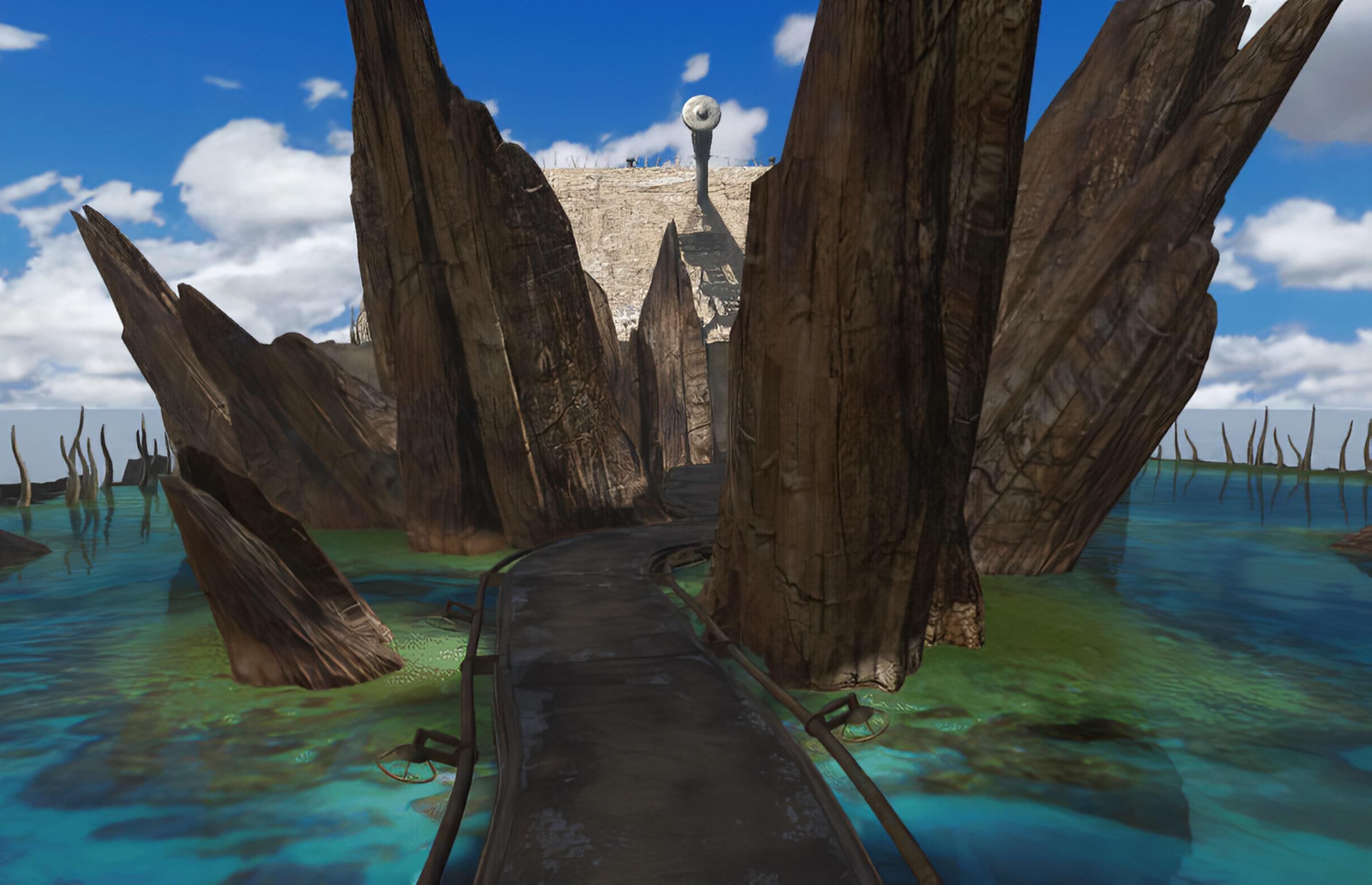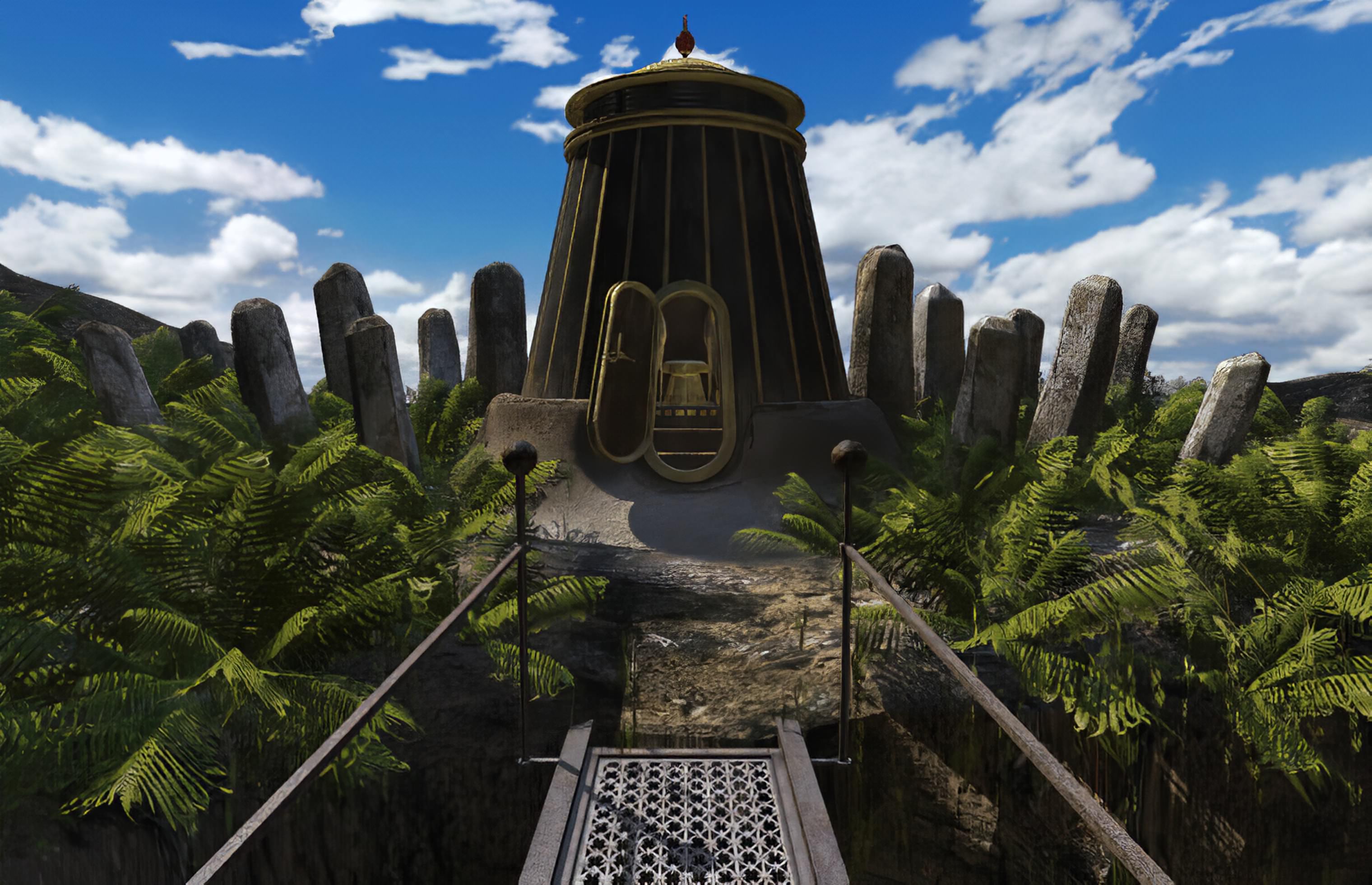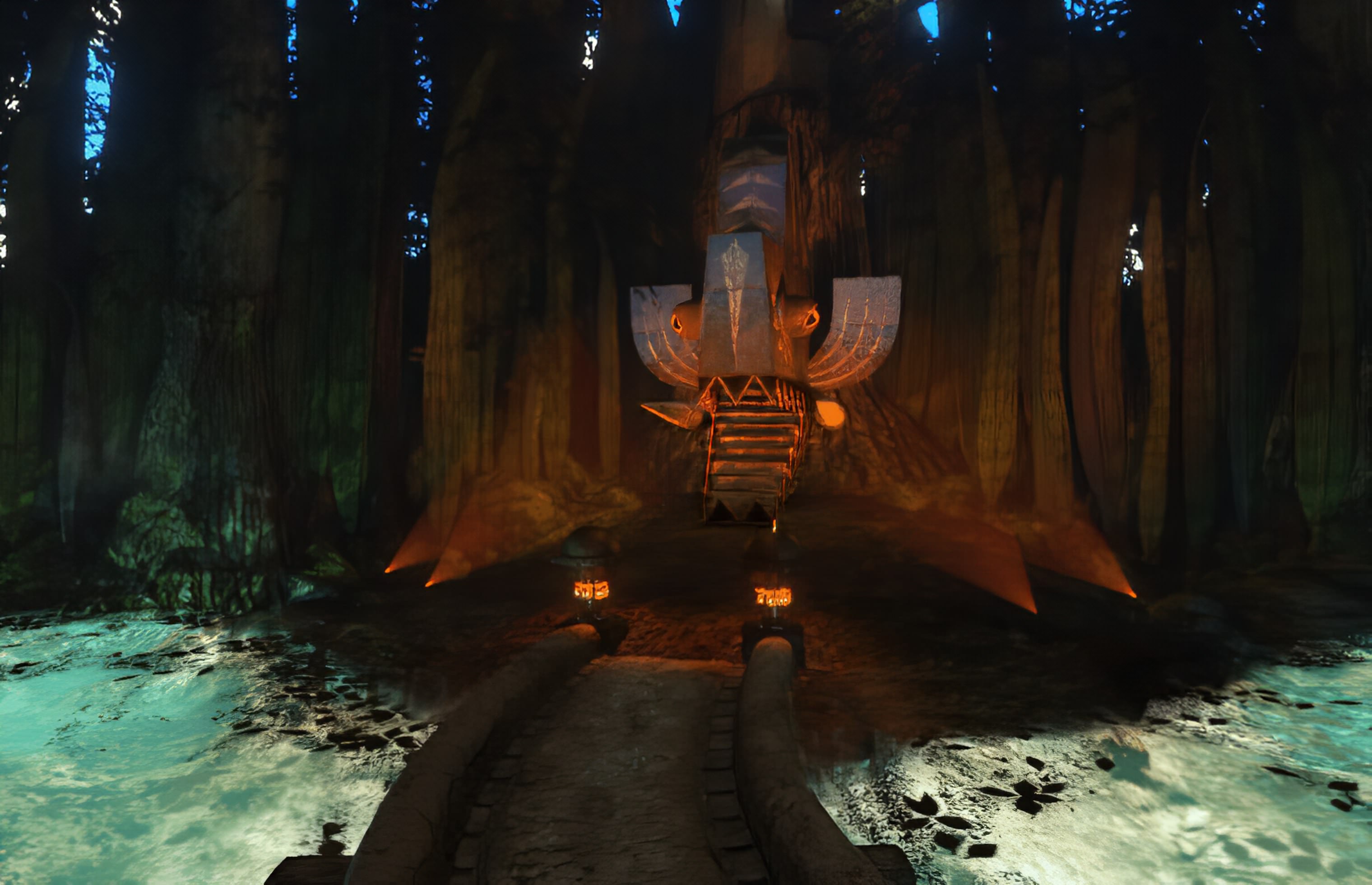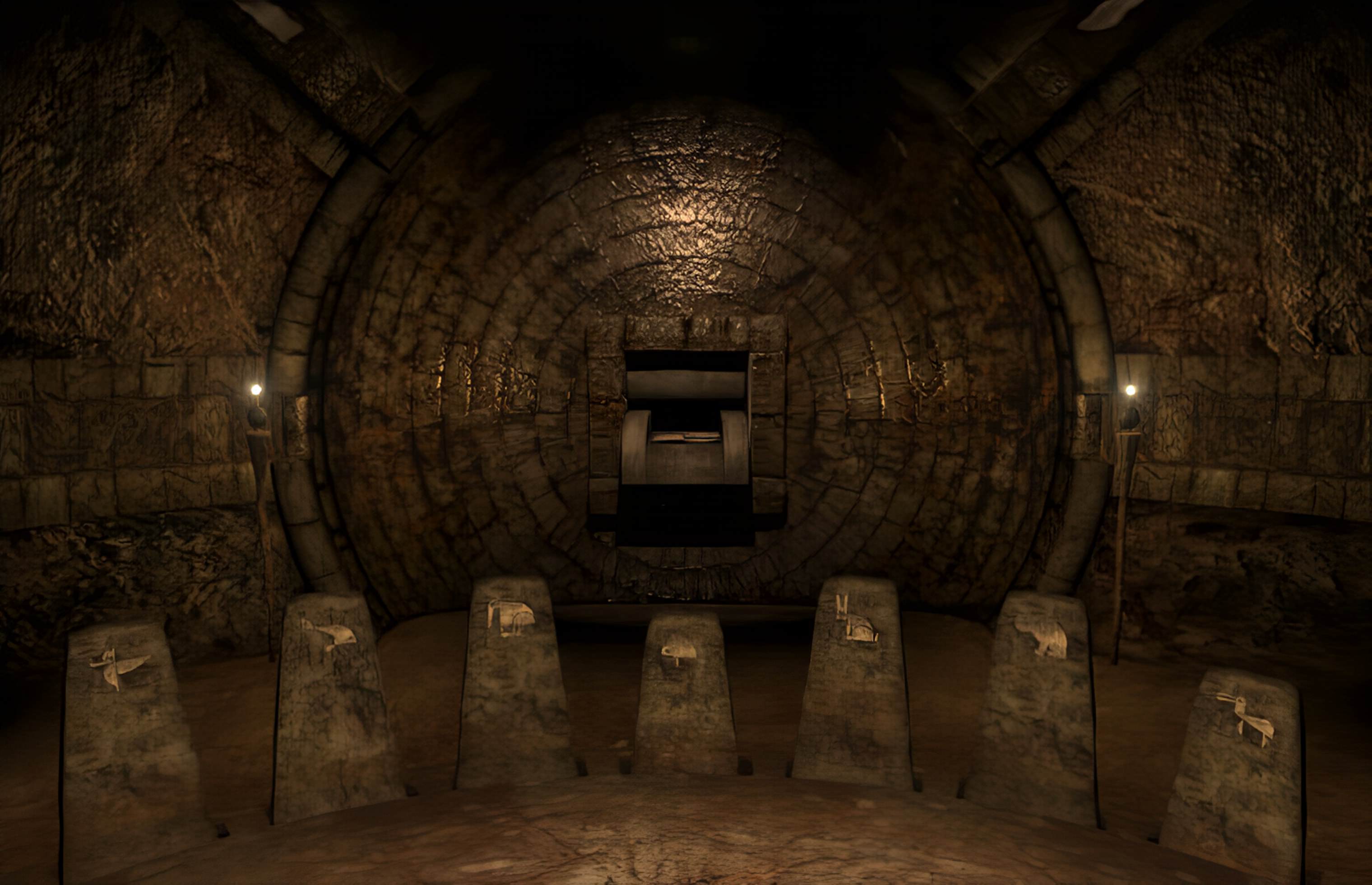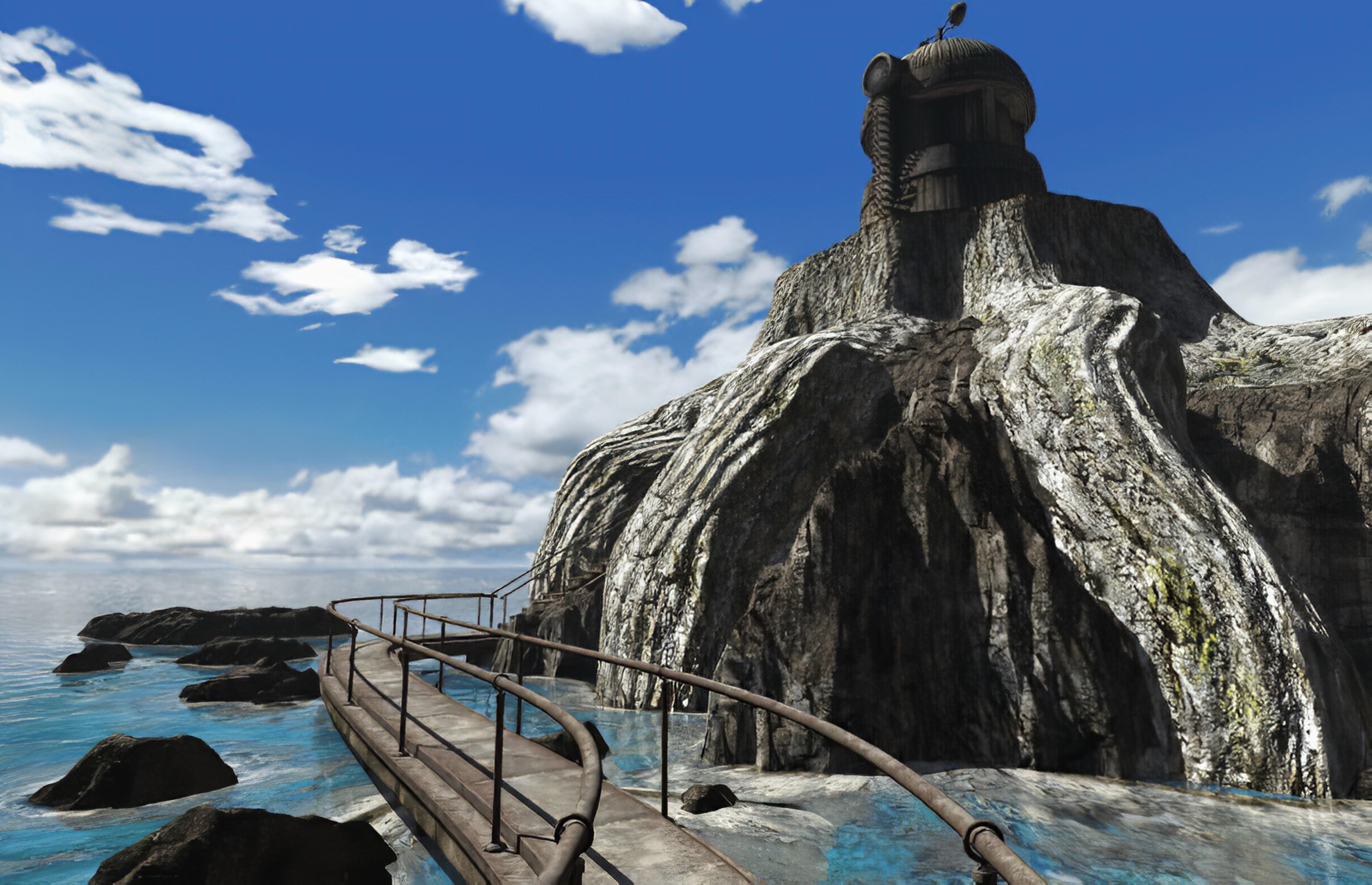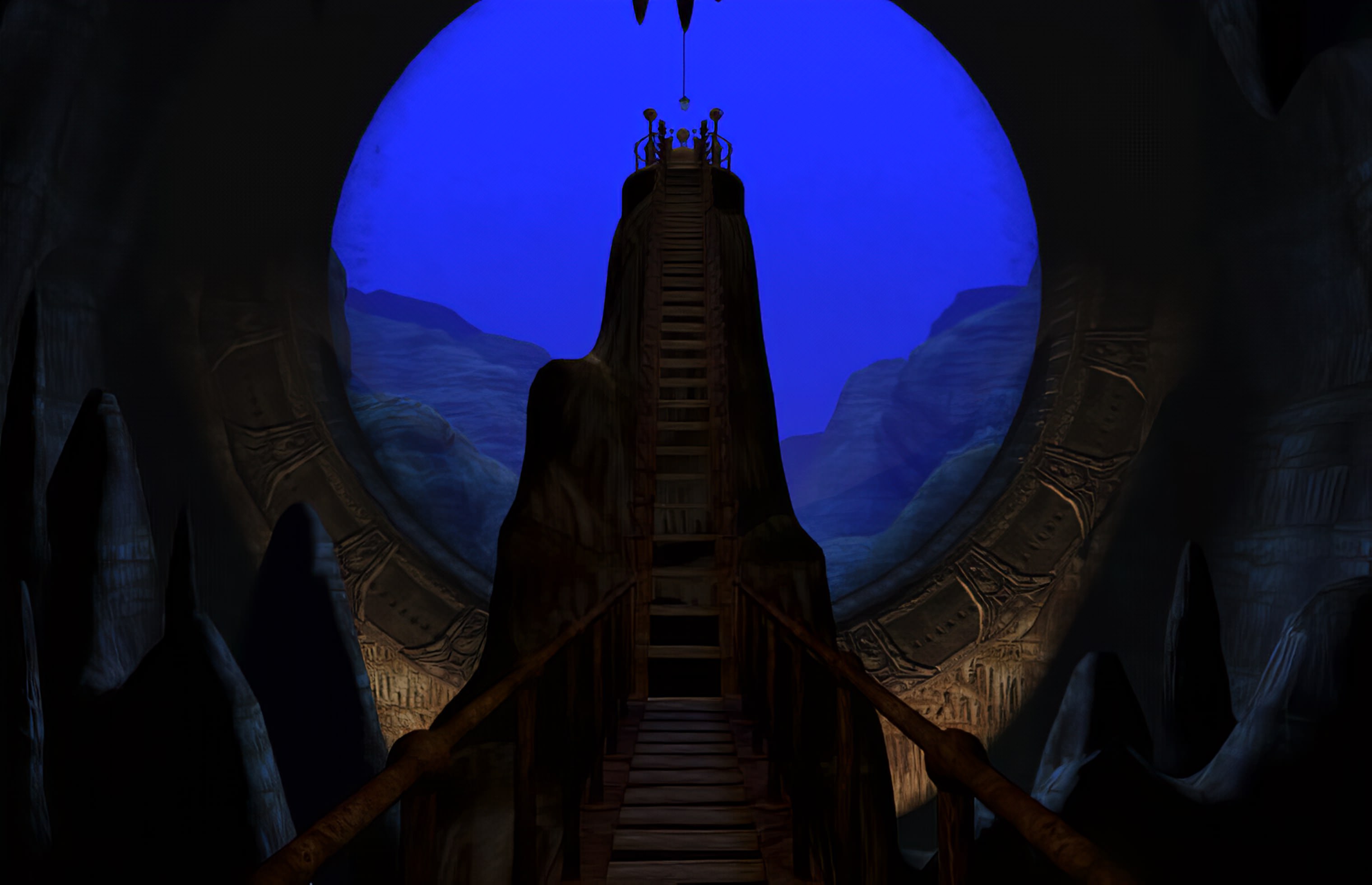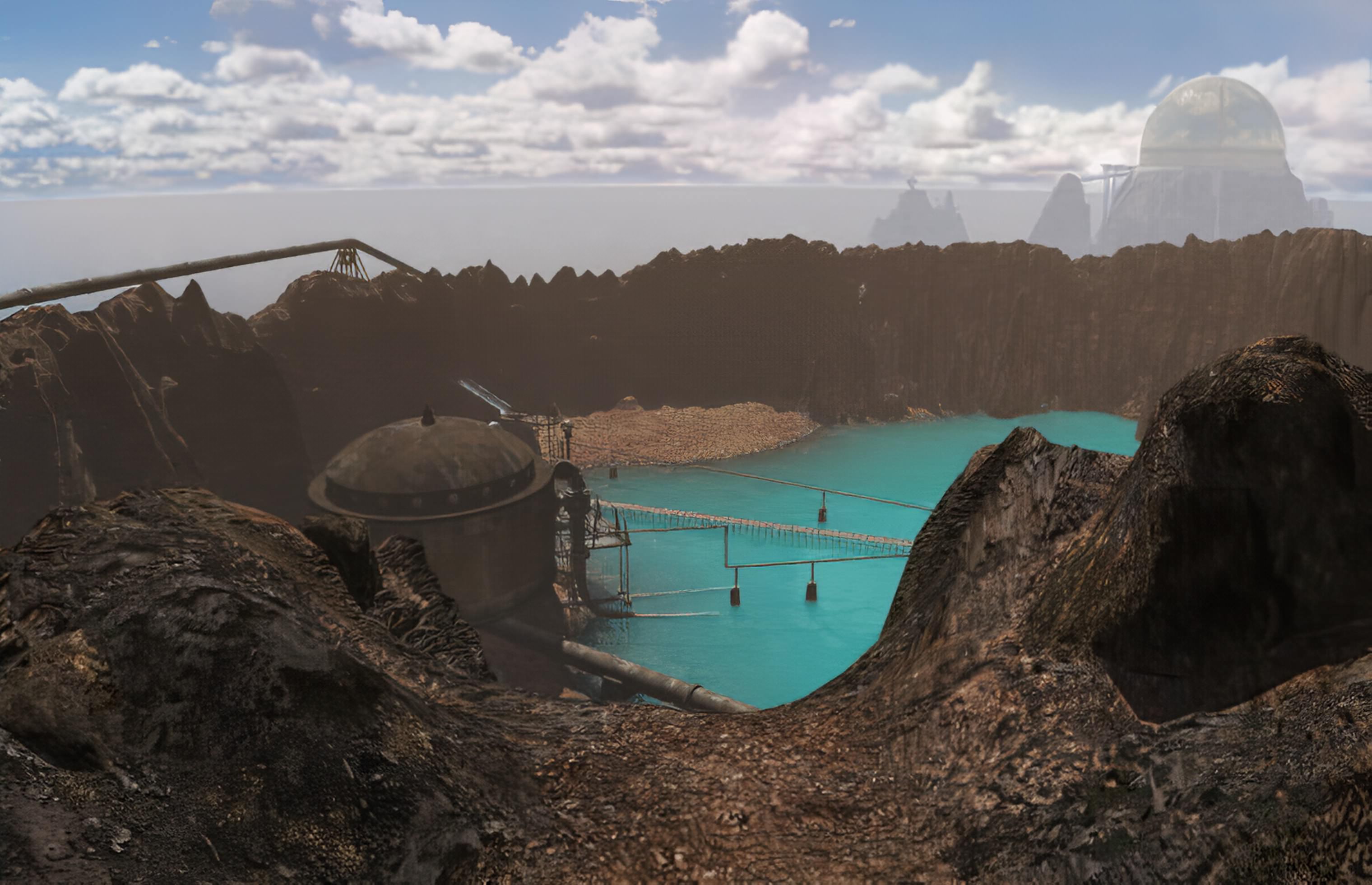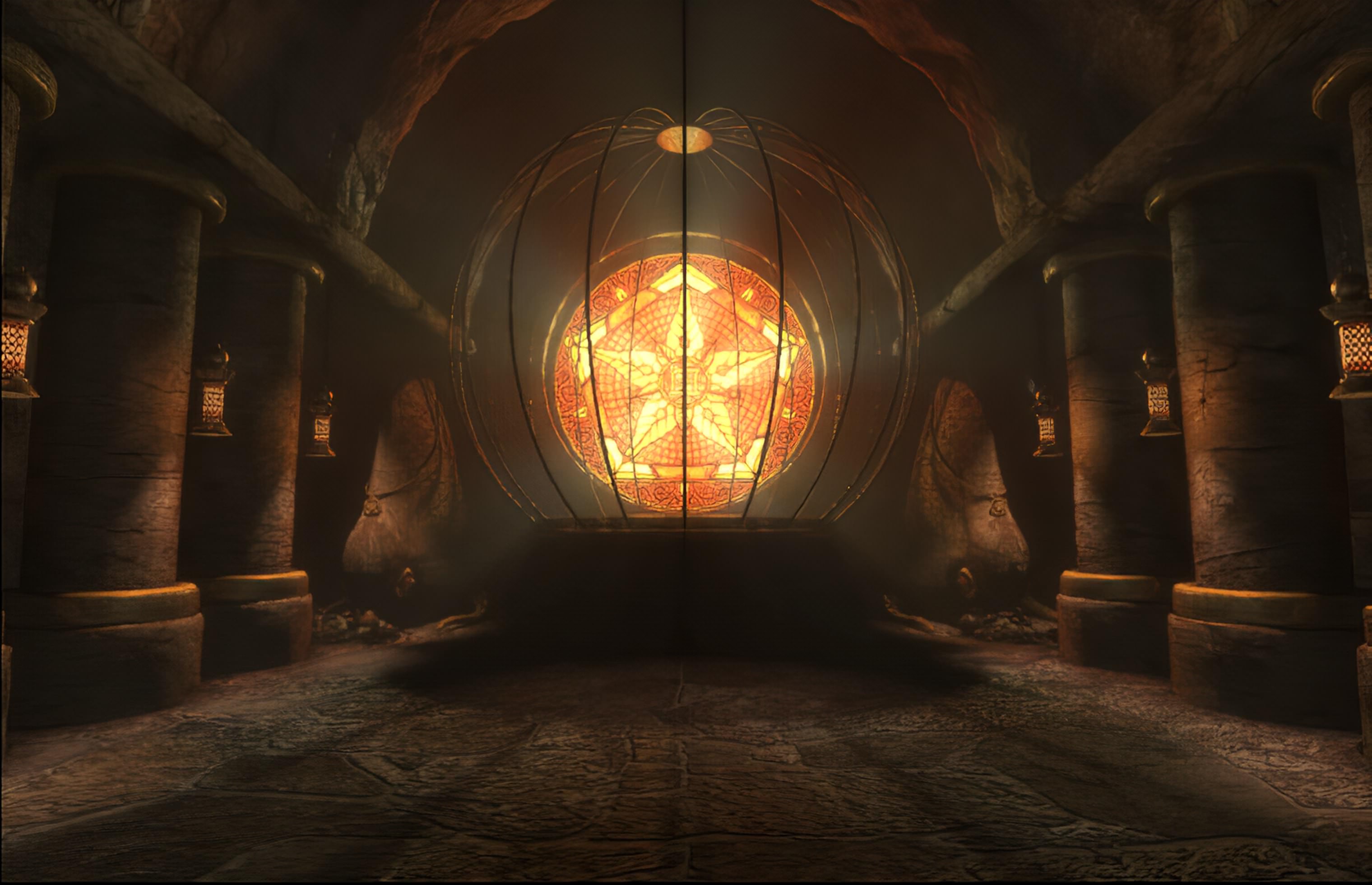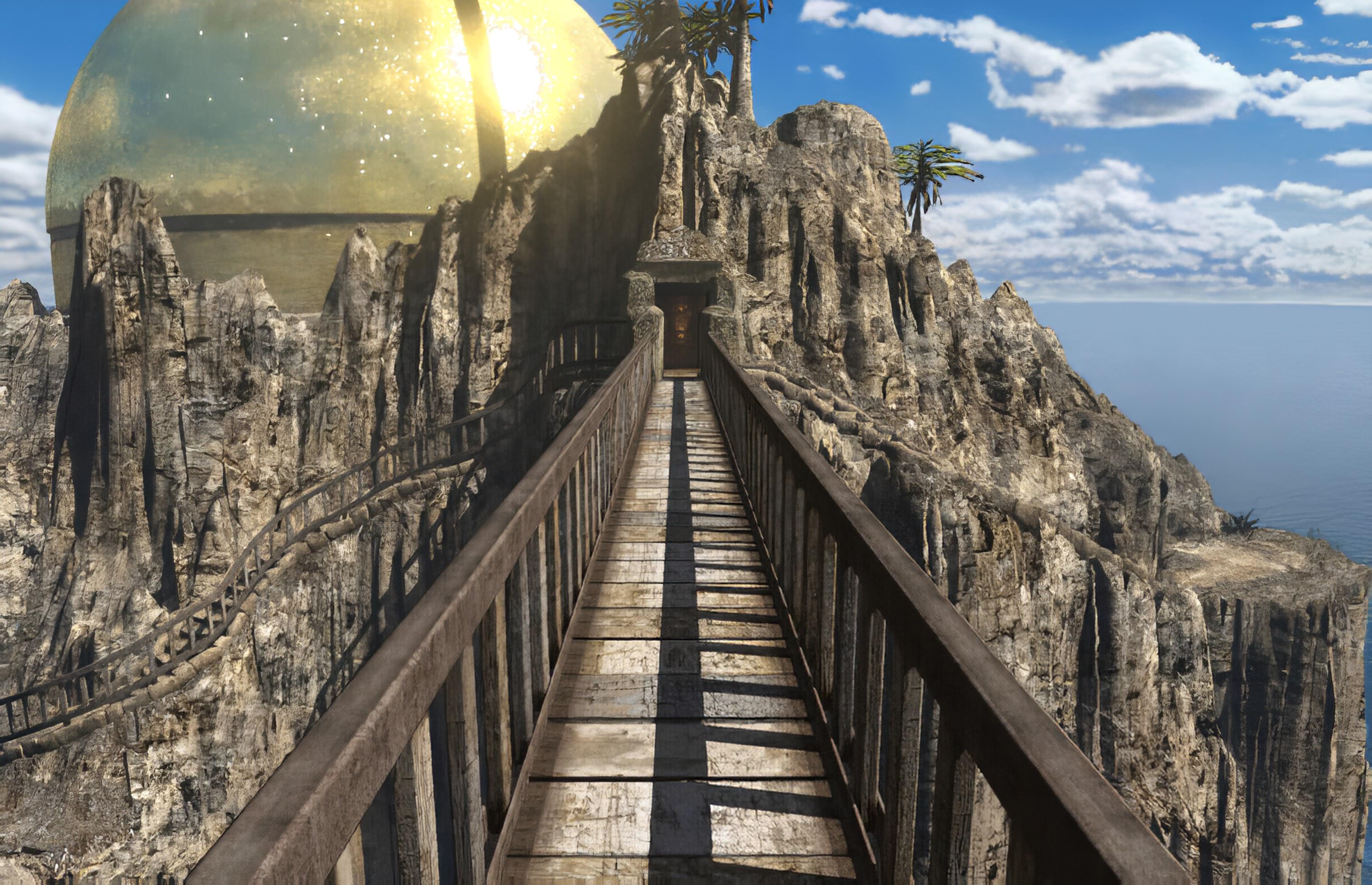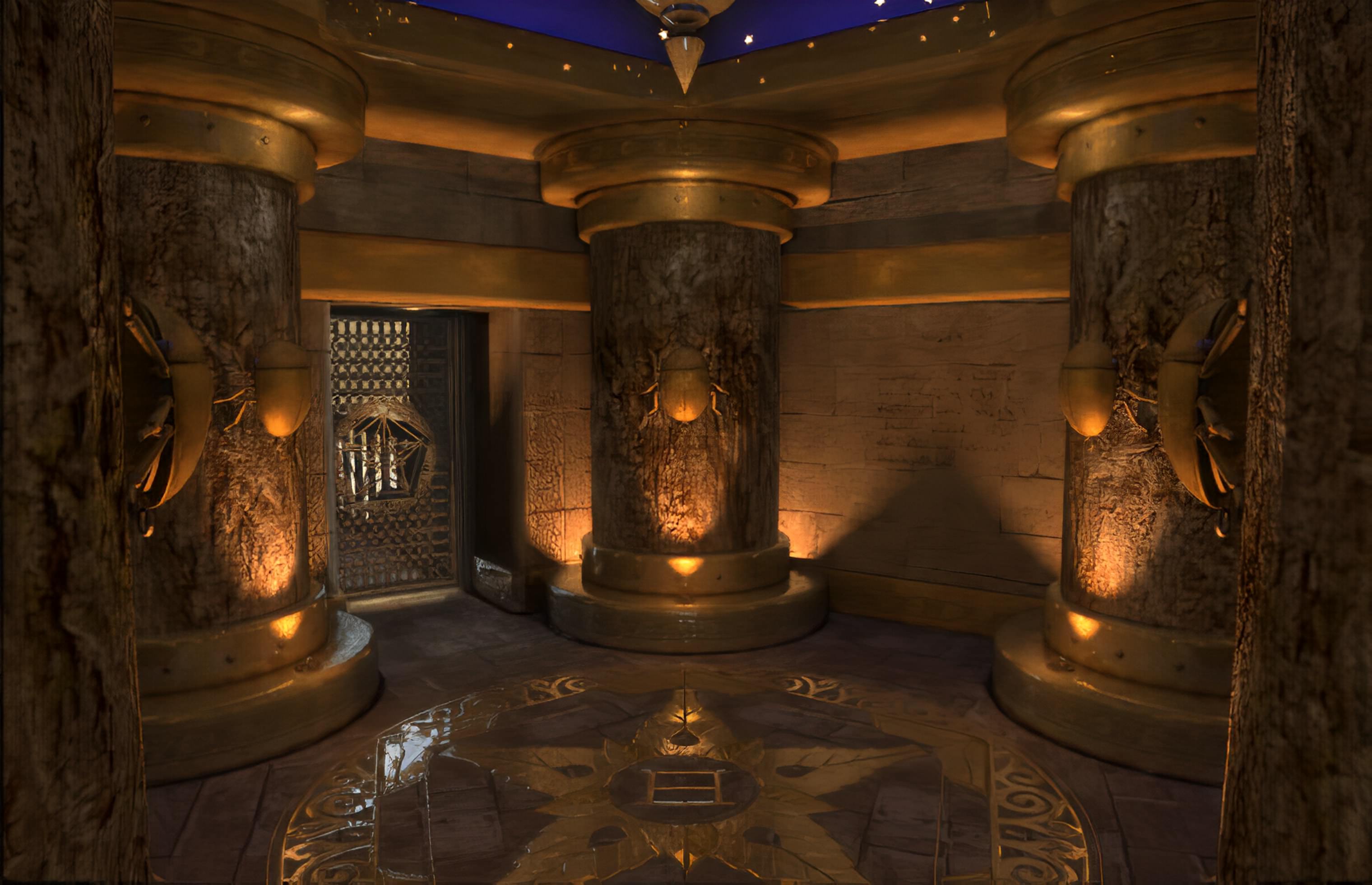RIVEN is an absolutely gorgeous game, with a staggering attention to detail, but it has been for quite some time, in dire need of a UI overhaul.
A point-and-click 640x480 interface was fine in the mid-1990s but it's not going to gain a positive reaction for the modern gamer encountering this title for the first time. One review of Riven's iOS port describes the graphics as 'ancient' but they were absolutely jaw-dropping when the game first released in 1997 and I'd argue they still hold up as believable even though the UI they're a part of is quite dated by modern players' standards.
So why play Riven now?
Simple. It's the closest that any Myst game has come to a fully-realized fantasy world. It's Myst's equivalent of J.R.R. Tolkien's "Lord of The Rings" - slow-paced but remarkably rich in atmosphere and tiny details. It's not our world but it's one that feels credible and real, one that has richness and texture and history to it.
The story is strong and at times nearly masterful in its use of environmental storytelling, and when that extends to FMV, the FMV is actually fairly good. Rand Miller is competent still as Atrus, Catherine's actress (Sheila Gould) is likewise well-handled, and the game has a stellar villain in Atrus's father, Gehn (John Keston) who comes across as coldly menacing.
Puzzles are few and often highly difficult, but they're logical and although they often require plenty of wandering around to obtain the information needed to put things together, the strength of them here is that absolutely every single puzzle BELONGS in that world and never once does one of them feel arbitrary or tacked on.
Sound design? Superb, everything from the sound effects to the music score which remains arguably the apex of Robyn Miller's soundtrack work.
The world of Riven has five major regions and its own political/social history with both its indigenous culture and the colonialist culture of D'ni imposed on top of it (and subsequent resistance movement), its own detailed ecology with intriguing flora and fauna, and geology, its own occasional odd physics rules, even its own native Rivenese language, roughly derived from a mixture of elements of language material in New Guinea. Which makes it the series' second fictional language after the D'ni language - which also appears here. The D'ni numeric system is also introduced in this title, and yes, you'll be expected to understand a little of it even though it's a highly inventive rotating base-25 numeric system.
So yes, this is absolutely a substantial game with a massive level of depth and thought poured into its design. Even the title. Riven. Riven means 'torn apart/asunder'. Which describes the family relationship between Atrus and his father, the societal divisions on the age of Riven, even the physical structure of the age itself that's starting to break apart. The logo for Riven even has an oversized 'V' in its center splitting the name of the game. And V is a Roman Numeral 'five' and Gehn's use of five as a motif is everywhere in Riven - an extension of his obsession with D'ni culture given that the D'ni numbers are base 25 (5 by 5) and Riven has five major areas, filled with details in fives, like five-pointed engraved stars, a set of five domes, etc. And the name of the age and game, Riven, has five letters - split in half by that V.
So yes, Cyan thought this all through.
Cyan spent four full years making this, four years with 25 staff, a new studio space, and the latest technology for the time. They used Softimage, plus some custom shaders and tools built on top of it, and ran it on a batch of SGI workstations that were then the highest-end PCs possible to buy short of supercomputer custom builds. They cost $50,000 each circa 1994, and Cyan today refers to them as "expensive doorstops".
Even with such a cutting-edge rendering system, the gameworld was a true behemoth of intricate 3d data, and most frames of Riven took at least 2-3 hours to render for each of the game's 4000 stills.
Riven was a $10 million project for Cyan, roughly 15 times the production cost of 'Myst'.
Riven would go on to top the annual sales charts of 1997, the best selling PC game of that year.
The game's sales totals are disputed - some claimed 3.5 or 4.5 million but arguments since have been made that these originated with a typo at that the actual figure may have been 1.5 million in the first twelve months of release and a few hundred thousand perhaps in later years since.
Myst fit on just one CD-ROM, but Riven? Riven was split onto five CDs or, in a slightly less compressed variation, one DVD. It was not a small game.
If Myst takes players around 10-15 hours to complete with no hints, or 4-5 in absolute best case, Riven often takes 25-40 hours without assistance, or 7-10 at minimum. It's not impossible to beat Riven but it's a genuine challenge and pretty hopeless if you aren't focused on the game and immersed in its world.
I saw one family member skip past the opening cinematics on the iOS version. That was a mistake. Don't do that! If you're impatient enough to be doing that... you're not the sort of person who will make it very far here. The opening scene with Atrus, pretty fully lays out in some rough form the entire outline of the game and central objectives. What Atrus is doing, what you need to do, and why.
Gehn is there ruling this world as a tyrant. He expects Atrus to return but this plan hinges on the fact that he does not know who you are. Find a way to trap Gehn somewhere outside of Riven (using a provided linking book). Rescue Catherine (Atrus's wife) so she can evacuate the Rivenese people and then return home to Atrus. Finally, signal Atrus to return with a link out.
There are other ages accessible during Riven, but they're very limited in scope compared to Riven itself. One is Tay, the Moiety/rebel age, another is Age 233 (Gehn's lab). They're pretty fascinating in their own right - Tay is so memorable that the view of it even is the singular image that appears on the box cover - and as a player I wished to see more of these other worlds as well as more of Riven itself.
In all, Riven was an extraordinary work of interactive art. It was astoundingly immersive, even enchantingly so, for its time and when Cyan remakes it in the near future - which they're doing - I imagine it'll wow people all over again.
Myst, when it first emerged, was beloved by critics, within gaming and outside of it. Rolling Stone, Time, other magazines that weren't even gaming-focused celebrated Myst as a maturation of video games to being a more fully realized art form. This acclaim helped spur further massive sales, which in turn triggered a burning backlash among many male gamers and 'gatekeepers' of gaming who did not understand or respect Myst's success.
So when Riven showed up and did what Myst did again, but even better in many areas, there were plenty of people, typically younger male gamers, predisposed to hate on its inevitable popularity.
Myst as a series is somewhat classifiable as fantasy/interdimensional steampunk but it avoids the pitfalls of steampunk which can risk glorifying a Victorian era culture. Riven is fairly clearly not doing so - its message is clearly anti-colonialist, anti-imperialist, pro-freedom. In this way it uses the steampunk theme as a means to critique, not celebrate, historical wrongs and abuses of power by the white male European/American establishment.
Though the creators of the series over time have been predominantly white men, the Myst fanbase is a weird one by gaming standards as it skews older due to the heyday of the series havign been in the 1990s - and it also skews female, about 60% of participants in the fanbase are women, and as a result Uru remains the only MMO I've ever seen where the avatar is by default set to female.
Cultural backlash to the Myst series largely stems from those who find the games too slow in pacing, and too 'boring' and simply dislike puzzles. It's been largely a result of bro gamers who keep trying to dismiss games that appeal to female audiences as anomalies, whether it's the enormous success of Myst, or 'The Sims' when it became the first game to exceed Myst's record-breaking PC game sales total in 2002. Yet there's clearly a major market for games that appeal to atypical gamers and expand the number of people playing video games.
While John Carmack was for a moment infuriated by Myst topping Doom on sales charts circa '93, he must have realized at some point that Myst's audience was VERY different from Doom's, and that Myst's success was not really cutting into Doom's sales. Today of course, iD's Carmack and Cyan CEO Rand Miller are relaxed around each other and have met in person, and are in positions that complement and do not compete. Carmack retains an investment in VR, having helped create the original Oculus prototypes, and Cyan has embraced VR as a way to immerse players as much as possible in their worlds. So the two studios both believe strongly in VR as a gaming field that is promising and they understand that when VR succeeds, that helps them both.
And in the end... bro gamers won. Myst's general brand of gaming is niche and no longer widely relevant. That said: It's still possible someone will push something *sort of like* Myst into the zeitgeist again someday. It just requires a few fresh puzzle mechanics and good execution. As genres come and go in cycles, so Myst opened up a subgenre with [potential] mass appeal if done right, a genre that won't ever fully vanish but is for now, sort of resigned to obscurity.
As for whether Myst or Riven 'killed' the adventure genre, I'd argue they kept the genre in the public eye longer and more prominently than it otherwise might have been. Other truly innovative adventure titles were routinely tanking on the sales charts by 1997, including even the excellent 'Grim Fandango' [1996] which is often considered one of the best in the category. Riven's status as a sales hit helped prop up the perception of continuing success for the broader puzzle/adventure category and possibly made it seem 'still viable' at least a bit longer, perhaps even helping the likes of not only additional Myst titles but circa-2000 classics like 'The Longest Journey' and 'Syberia' get off the ground.
And even today, long after the genre's supposed 'death', there are puzzle/adventure titles being made, usually by the indie developer scene that has boomed since the mid 2000s and that has taken inspiration from the genre and from Myst, and pushed the category in new directions.
This genre is in no way dead, only dormant and currently resigned to the background, the land of indie gaming. The closest that any type of puzzle game has come to a mainstream resurgence since the 1990s was in 2007, with 'Portal' and that was a puzzle platformer, not a classic adventure game.
People continue building wildly creative puzzles and merging them with different other elements. Mostly that doesn't get huge but occasionally it works well enough to gain some popularity.
Mobius Games' "Outer Wilds' [2019] may well be the best recent example of what today is becoming known as a metroidbrania - a term that has been applied to everything from Fez to The Witness to Tunic. Basically it's a term for a game where a holistic understanding of the game's logic, mechanics, and world is the means to make progress. Outer Wilds is a game which is possible to beat in 20 minutes but it takes the typical player nearly 20 hours to understand it and put it all together well enough to get that final 20-minute sequence to work successfully. The Witness similarly hides a huge secret ending in the first ten minutes of the game and few realize it is there at all until many hours and numerous disappointing false endings in.
Myst and Riven were early foundational pushes in this direction. Myst is possible to complete in five minutes with a code that you'd only know after playing through everything else, but to rush to the end with that code is to miss the point of the experience. The 'epic wins' in these titles are moments of 'aha!' where something clicks and suddenly connects to something else in a way that makes sense, and allows for a thing to happen that unlocks more of the world and story.
Riven was arguably a peak for Cyan as a game studio creatively, but it was also the start of Cyan's decline commercially. Myst blew the world away in '93 and Riven, despite being intricately detailed and deep on a whole other level, was only half as successful on sales charts.
I personally get the sense, having discussed my Myst obsession with others, that many of them couldn't get through Myst itself, much less Riven, which was the wider problem with this series. Myst was hard enough that many more casual gamers roped in by the then-amazing artistry of it never finished the thing, and Riven was harder than Myst was. Which meant no Myst title of any kind after Riven actually ever managed to sell even two million copies.
Riven, then, was the last time Cyan had any sort of chart topping big hit doing their thing. They've never again managed to recapture that cutting-edge lightning in a bottle. Myst and Riven were both impressive acheivements that pushed the art of gaming forward into a range of realism that had previously not been reached. Cyan was never able to pull that sense of technological novelty off that again, and no matter how much effort went into their art direction, storytelling, puzzles, or sound design, the world had largely moved on and lost interest.
A point-and-click 640x480 interface was fine in the mid-1990s but it's not going to gain a positive reaction for the modern gamer encountering this title for the first time. One review of Riven's iOS port describes the graphics as 'ancient' but they were absolutely jaw-dropping when the game first released in 1997 and I'd argue they still hold up as believable even though the UI they're a part of is quite dated by modern players' standards.
So why play Riven now?
Simple. It's the closest that any Myst game has come to a fully-realized fantasy world. It's Myst's equivalent of J.R.R. Tolkien's "Lord of The Rings" - slow-paced but remarkably rich in atmosphere and tiny details. It's not our world but it's one that feels credible and real, one that has richness and texture and history to it.
The story is strong and at times nearly masterful in its use of environmental storytelling, and when that extends to FMV, the FMV is actually fairly good. Rand Miller is competent still as Atrus, Catherine's actress (Sheila Gould) is likewise well-handled, and the game has a stellar villain in Atrus's father, Gehn (John Keston) who comes across as coldly menacing.
Puzzles are few and often highly difficult, but they're logical and although they often require plenty of wandering around to obtain the information needed to put things together, the strength of them here is that absolutely every single puzzle BELONGS in that world and never once does one of them feel arbitrary or tacked on.
Sound design? Superb, everything from the sound effects to the music score which remains arguably the apex of Robyn Miller's soundtrack work.
The world of Riven has five major regions and its own political/social history with both its indigenous culture and the colonialist culture of D'ni imposed on top of it (and subsequent resistance movement), its own detailed ecology with intriguing flora and fauna, and geology, its own occasional odd physics rules, even its own native Rivenese language, roughly derived from a mixture of elements of language material in New Guinea. Which makes it the series' second fictional language after the D'ni language - which also appears here. The D'ni numeric system is also introduced in this title, and yes, you'll be expected to understand a little of it even though it's a highly inventive rotating base-25 numeric system.
So yes, this is absolutely a substantial game with a massive level of depth and thought poured into its design. Even the title. Riven. Riven means 'torn apart/asunder'. Which describes the family relationship between Atrus and his father, the societal divisions on the age of Riven, even the physical structure of the age itself that's starting to break apart. The logo for Riven even has an oversized 'V' in its center splitting the name of the game. And V is a Roman Numeral 'five' and Gehn's use of five as a motif is everywhere in Riven - an extension of his obsession with D'ni culture given that the D'ni numbers are base 25 (5 by 5) and Riven has five major areas, filled with details in fives, like five-pointed engraved stars, a set of five domes, etc. And the name of the age and game, Riven, has five letters - split in half by that V.
So yes, Cyan thought this all through.
Cyan spent four full years making this, four years with 25 staff, a new studio space, and the latest technology for the time. They used Softimage, plus some custom shaders and tools built on top of it, and ran it on a batch of SGI workstations that were then the highest-end PCs possible to buy short of supercomputer custom builds. They cost $50,000 each circa 1994, and Cyan today refers to them as "expensive doorstops".
Even with such a cutting-edge rendering system, the gameworld was a true behemoth of intricate 3d data, and most frames of Riven took at least 2-3 hours to render for each of the game's 4000 stills.
Riven was a $10 million project for Cyan, roughly 15 times the production cost of 'Myst'.
Riven would go on to top the annual sales charts of 1997, the best selling PC game of that year.
The game's sales totals are disputed - some claimed 3.5 or 4.5 million but arguments since have been made that these originated with a typo at that the actual figure may have been 1.5 million in the first twelve months of release and a few hundred thousand perhaps in later years since.
Myst fit on just one CD-ROM, but Riven? Riven was split onto five CDs or, in a slightly less compressed variation, one DVD. It was not a small game.
If Myst takes players around 10-15 hours to complete with no hints, or 4-5 in absolute best case, Riven often takes 25-40 hours without assistance, or 7-10 at minimum. It's not impossible to beat Riven but it's a genuine challenge and pretty hopeless if you aren't focused on the game and immersed in its world.
I saw one family member skip past the opening cinematics on the iOS version. That was a mistake. Don't do that! If you're impatient enough to be doing that... you're not the sort of person who will make it very far here. The opening scene with Atrus, pretty fully lays out in some rough form the entire outline of the game and central objectives. What Atrus is doing, what you need to do, and why.
Gehn is there ruling this world as a tyrant. He expects Atrus to return but this plan hinges on the fact that he does not know who you are. Find a way to trap Gehn somewhere outside of Riven (using a provided linking book). Rescue Catherine (Atrus's wife) so she can evacuate the Rivenese people and then return home to Atrus. Finally, signal Atrus to return with a link out.
There are other ages accessible during Riven, but they're very limited in scope compared to Riven itself. One is Tay, the Moiety/rebel age, another is Age 233 (Gehn's lab). They're pretty fascinating in their own right - Tay is so memorable that the view of it even is the singular image that appears on the box cover - and as a player I wished to see more of these other worlds as well as more of Riven itself.
In all, Riven was an extraordinary work of interactive art. It was astoundingly immersive, even enchantingly so, for its time and when Cyan remakes it in the near future - which they're doing - I imagine it'll wow people all over again.
Myst, when it first emerged, was beloved by critics, within gaming and outside of it. Rolling Stone, Time, other magazines that weren't even gaming-focused celebrated Myst as a maturation of video games to being a more fully realized art form. This acclaim helped spur further massive sales, which in turn triggered a burning backlash among many male gamers and 'gatekeepers' of gaming who did not understand or respect Myst's success.
So when Riven showed up and did what Myst did again, but even better in many areas, there were plenty of people, typically younger male gamers, predisposed to hate on its inevitable popularity.
Myst as a series is somewhat classifiable as fantasy/interdimensional steampunk but it avoids the pitfalls of steampunk which can risk glorifying a Victorian era culture. Riven is fairly clearly not doing so - its message is clearly anti-colonialist, anti-imperialist, pro-freedom. In this way it uses the steampunk theme as a means to critique, not celebrate, historical wrongs and abuses of power by the white male European/American establishment.
Though the creators of the series over time have been predominantly white men, the Myst fanbase is a weird one by gaming standards as it skews older due to the heyday of the series havign been in the 1990s - and it also skews female, about 60% of participants in the fanbase are women, and as a result Uru remains the only MMO I've ever seen where the avatar is by default set to female.
Cultural backlash to the Myst series largely stems from those who find the games too slow in pacing, and too 'boring' and simply dislike puzzles. It's been largely a result of bro gamers who keep trying to dismiss games that appeal to female audiences as anomalies, whether it's the enormous success of Myst, or 'The Sims' when it became the first game to exceed Myst's record-breaking PC game sales total in 2002. Yet there's clearly a major market for games that appeal to atypical gamers and expand the number of people playing video games.
While John Carmack was for a moment infuriated by Myst topping Doom on sales charts circa '93, he must have realized at some point that Myst's audience was VERY different from Doom's, and that Myst's success was not really cutting into Doom's sales. Today of course, iD's Carmack and Cyan CEO Rand Miller are relaxed around each other and have met in person, and are in positions that complement and do not compete. Carmack retains an investment in VR, having helped create the original Oculus prototypes, and Cyan has embraced VR as a way to immerse players as much as possible in their worlds. So the two studios both believe strongly in VR as a gaming field that is promising and they understand that when VR succeeds, that helps them both.
And in the end... bro gamers won. Myst's general brand of gaming is niche and no longer widely relevant. That said: It's still possible someone will push something *sort of like* Myst into the zeitgeist again someday. It just requires a few fresh puzzle mechanics and good execution. As genres come and go in cycles, so Myst opened up a subgenre with [potential] mass appeal if done right, a genre that won't ever fully vanish but is for now, sort of resigned to obscurity.
As for whether Myst or Riven 'killed' the adventure genre, I'd argue they kept the genre in the public eye longer and more prominently than it otherwise might have been. Other truly innovative adventure titles were routinely tanking on the sales charts by 1997, including even the excellent 'Grim Fandango' [1996] which is often considered one of the best in the category. Riven's status as a sales hit helped prop up the perception of continuing success for the broader puzzle/adventure category and possibly made it seem 'still viable' at least a bit longer, perhaps even helping the likes of not only additional Myst titles but circa-2000 classics like 'The Longest Journey' and 'Syberia' get off the ground.
And even today, long after the genre's supposed 'death', there are puzzle/adventure titles being made, usually by the indie developer scene that has boomed since the mid 2000s and that has taken inspiration from the genre and from Myst, and pushed the category in new directions.
This genre is in no way dead, only dormant and currently resigned to the background, the land of indie gaming. The closest that any type of puzzle game has come to a mainstream resurgence since the 1990s was in 2007, with 'Portal' and that was a puzzle platformer, not a classic adventure game.
People continue building wildly creative puzzles and merging them with different other elements. Mostly that doesn't get huge but occasionally it works well enough to gain some popularity.
Mobius Games' "Outer Wilds' [2019] may well be the best recent example of what today is becoming known as a metroidbrania - a term that has been applied to everything from Fez to The Witness to Tunic. Basically it's a term for a game where a holistic understanding of the game's logic, mechanics, and world is the means to make progress. Outer Wilds is a game which is possible to beat in 20 minutes but it takes the typical player nearly 20 hours to understand it and put it all together well enough to get that final 20-minute sequence to work successfully. The Witness similarly hides a huge secret ending in the first ten minutes of the game and few realize it is there at all until many hours and numerous disappointing false endings in.
Myst and Riven were early foundational pushes in this direction. Myst is possible to complete in five minutes with a code that you'd only know after playing through everything else, but to rush to the end with that code is to miss the point of the experience. The 'epic wins' in these titles are moments of 'aha!' where something clicks and suddenly connects to something else in a way that makes sense, and allows for a thing to happen that unlocks more of the world and story.
Riven was arguably a peak for Cyan as a game studio creatively, but it was also the start of Cyan's decline commercially. Myst blew the world away in '93 and Riven, despite being intricately detailed and deep on a whole other level, was only half as successful on sales charts.
I personally get the sense, having discussed my Myst obsession with others, that many of them couldn't get through Myst itself, much less Riven, which was the wider problem with this series. Myst was hard enough that many more casual gamers roped in by the then-amazing artistry of it never finished the thing, and Riven was harder than Myst was. Which meant no Myst title of any kind after Riven actually ever managed to sell even two million copies.
Riven, then, was the last time Cyan had any sort of chart topping big hit doing their thing. They've never again managed to recapture that cutting-edge lightning in a bottle. Myst and Riven were both impressive acheivements that pushed the art of gaming forward into a range of realism that had previously not been reached. Cyan was never able to pull that sense of technological novelty off that again, and no matter how much effort went into their art direction, storytelling, puzzles, or sound design, the world had largely moved on and lost interest.
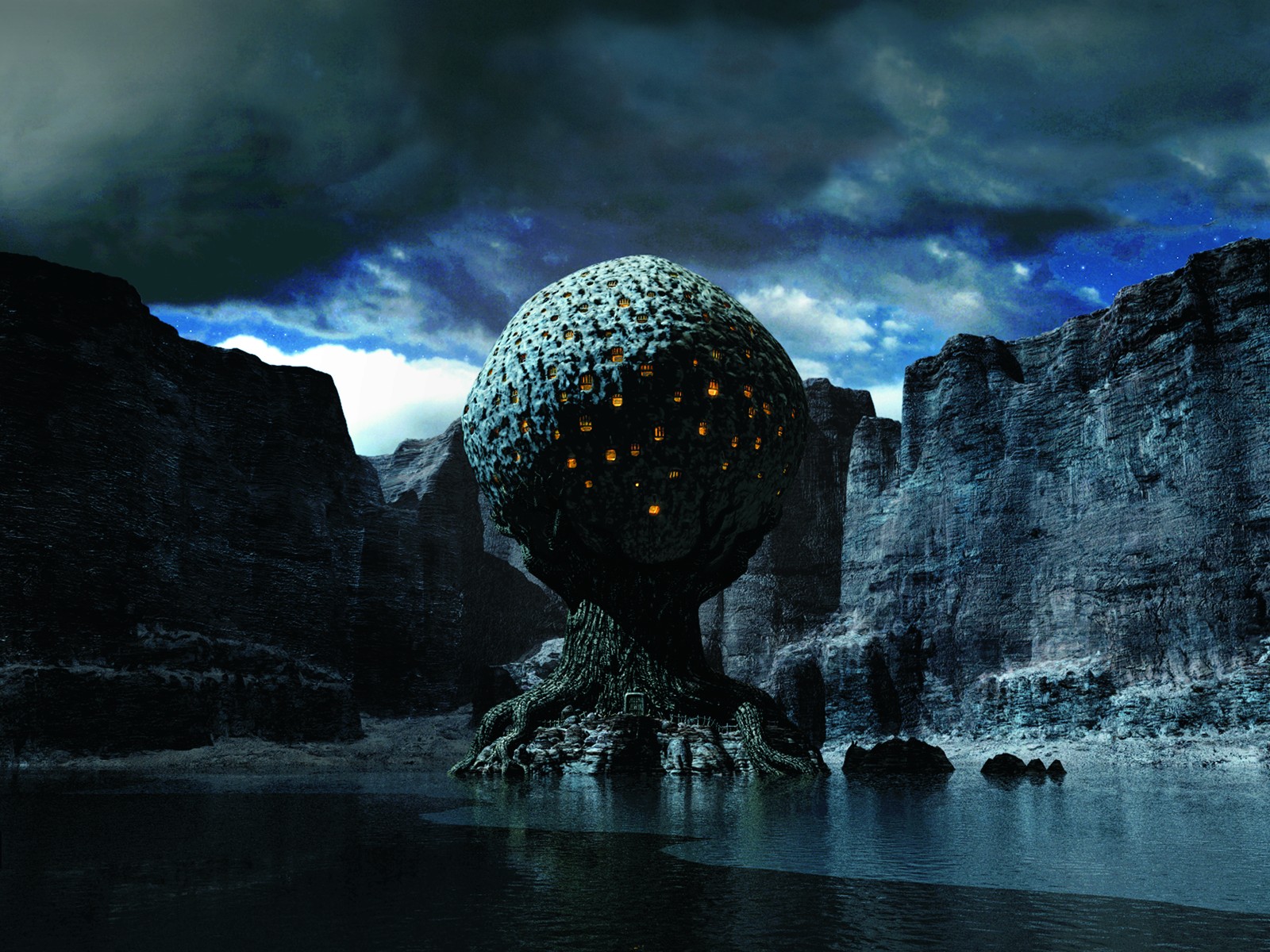
"It's not only phenomenal gaming, but a work of art." - Just Adventure (100/100)t
"This game is a masterpiece and worth every single penny." - Game Revolution (100/100)
"It's a perfect game for fans of this type of adventure and deserves to be every bit as popular as Myst." - Quandary, 10/10
"This game is so good that if I taught a class on interactive fiction, I would use it as my example of how to create a great quality game." - Adventure Gamers, 90/100
"I really loved this game, even more than I enjoyed Myst, but I would advise adrenaline junkies to stay far, far away." - Gamezilla, 9.2/10
"That dazzling indulgence for your eyes, coupled with the all-consuming sound effects, make this such an enjoyable world to wander through" - Adrenaline Vault, 9/10
"If you enjoyed Myst, you'll thoroughly enjoy Riven." - Gamespot, 78/100
"Even if you enjoyed Myst, you'll have a frustrating time with this sequel." - PC Gamer, 4/10
Consensus of all reviewers: 83/100
The puzzle design was the overwhelmingly singular drawback to Riven for most critics who had bad things to say, as puzzles in Riven, though they fit the world seamlessly, by nature of that decision could be hard to separate from non-puzzle elements, and given the sheer size of Riven's central gameworld, pieces of information that players had to put together could be scattered far apart, making it difficult to put them together and often requiring a lot of backtracking. The 'marble' puzzle near the end makes sense but is deeply problematic in that it requires much backtracking and for many players much trial and error in placing certain marbles in the correct exact spots. As with Myst, be prepared to take notes and maybe map some things out.
The good news is the world remains beautifully crafted and dense in detailing even though you'll go through some areas a bunch of times by the end.
The second drawback to Riven is a more modern one that is seen often in reviews of the iPad port: The game's UI is ancient, low-resolution, and clunky, by modern players' standards.
Set these two problems aside and most every other aspect of Riven still fully holds up.
AND THE GOOD NEWS IS:
They absolutely nailed their remake.
88/100 metacritic, with the main mixed reviews being from the VR standalone form.
Playing directly on a Quest 2 or 3 with no airlink, no tether, no gaming desktop.
Cyan clearly made compromises to get the game to work at all on what, in processing terms, is a glorified smartphone in a headset. If you can play this using a PC and a good GPU to actually run the thing, that's preferable, whether you are playing on the PC directly or using that as a connection to a VR system.
Reviews are nearly all glowing from those who meet the minimum requirements or exceed them, using a desktop - there's one critic who had a five year old laptop that was overheating while playing Riven, and that was a NYT critic who normally is not assigned game reviews. They thought the game was stressing their hardware and that it scared them that it might cause the laptop to fail. They also made basic factual errors in discussing the game, claiming that the obsessive and beautiful detail of the visuals should not have been Cyan's focus, instead they should have added new ares and new puzzles.
Which... they did. There are new areas and puzzles. The two worlds branching off from Riven itself (Tay, and Age 233) contain at least double the explorable area than they had in the 1997 original, and while the central age of Riven is not so massively extended it too definitely has some new spaces. One of these, core to a reworked puzzle, feels absolutely magical when you discover it the first time. New passages offer secret shortcuts, existing puzzles are reworked with more stages and flow far better with clearer indication of progression. New lore exists around firemarbles, the Rivenese culture, the Starry Expanse and Gehn himself. The new music tracks attached to new places vary but some like the new music around Prison Island, are absolutely hauntingly perfect for the site. So this is clearly a bigger game than veteran players expected, and one where some aspect of nearly every existing puzzle gets cleverly shaken up. There's an acheivement for entering a 1997 solution - even though here, that solution is no longer valid. Further, some puzzles are randomized, and that's fairly cool.
2024's Riven solves the two biggest problems with the original. By streamlining and adding smaller chunks and subsets to big puzzle setups, removing certain pixel-hunt moments, 2024's Riven makes the flow of solving the puzzles a little easier than before and yet still challenging, with some of the most aggravating parts simplified, new elements and complications added in ways that are pretty interesting. The new Riven also expands the world and makes it far more immersive with a modern UI and tech - this is Unreal Engine 5.3, and the capabilities of Unreal combined with these top tier artists results in some of the most compelling imagery I have ever seen in any game ever. The character graphics don't look so amazing, granted, but they at least tried. 3d characters cannot look as real as real people (FMV in the original is hard to match) so comparisons relating to characters will tend negative, but 3d characters work better for the stereo nature of VR and while these characters won't look photoreal, they're much better than what we saw in 2021's Myst remake, and the fact that every part of this was done with full mocap lends a certain level of naturalism to the movement, which helps.
Other things - environmental elements from craggy rocks to flowing water reflecting caustic patterns on nearby surfaces, to foliage, wildlife, machinery and structures, it all is so meticulously detailed and believable it is almost like seeing the place for the first time when previously everything was like looking with a squint. Riven in 1997 held up as realistic mainly because it was rendered at 640x480, and when it is seen in making of material rendered out in HD in the few places that was ever done, it looks artificial. Here, for me, the settings are all holding up on a monitor with 2.7k resolution and look stunningly detailed. And it's running smoothly too at 90+ fps. My desktop was top tier three years ago and every part of it is 2021 era. This game looks incredible running on it.
System requirements may be high but this thing is graphically gorgeous on a good system, while also looking decent on a midrange one. Some people are running Riven on 2018, 2019 era desktops that fall short slightly of one or two system requirements and finding it still looks pretty good. It's not poorly optimized but it also will not look as nice on an aging system. On a good gaming rig, it will be impressive.
The game was made by a core team of about 20 people. It's a five million dollar production, approximately. We've seen Cyan struggle with games that clearly cut some stuff and had design limitations due to financial constraints. $1.35 million on Obduction, or on Firmament, these sound huge until you realize they're (inflation adjusted) no bigger than what financed Myst in 1991. Indeed, 1.4 million in 2023 is *less* than the $650k that covered the salaries of the team of seven who made Myst.
5 million for Riven in 2024, considering inflation, is under a third the $10 million amount that went into it the first time from 1993-1997. The fact that they had these constraints and made a FAR BETTER version this time, from scratch rebuilding and expanding it all with higher levels of detailing, with a smaller team and tighter schedule, is an indication of the sheer skill and drive of the team they have now, and of the reality that the tools available to artists now are simply vastly better on both software and hardware sides. Nearly every change is thought out well and adds to the game in some meaningful way, and many spaces in the remake - if scaled down to 640x480 and viewed from the exact right angle, are nearly indistinguishable from the original game's equivalents. But unlike the originals, these have much higher detail levels and are possible to walk around in and look at from any direction you want to.
In the past 27 years, these worlds that took four hours to render a single still in SD with a quarter million dollars of networked hardware, now render in 4k at 60+ fps on a single $1000 desktop at home. The world we live in has changed drastically in 27 years yet this gameworld and its aesthetic and story remain just as compelling today as ever. The strengths of the original - the art direction, visual realism, story/lore and sound design/music are retained, expanded, and improved on. The things that were in retropect a bit clunky in the original from the static UI to the uneven qualities of some puzzles, are drastically improved here to the point of being wondrously refreshing.
2024's Riven is the definitive version of what has long been regarded as among the best puzzle adventure titles ever created and it's not even close. This is masterful creative work that comes near to being perfect.
The Cyan crew here is absolutely at the top of their game. No question. This title has been compared in visual terms to groundbreaking AAA games by some players, yet it's 1% the budget of some of the games a few of the players try to compare it to (RDR2 was a $450 million production, guys! The fact that this even gets anywhere close to such detailing is something of a miracle!)
And yet... the actual Steam sales figures for the first month of release are estimated at somewhere between 40,000-60,000 based on all sources accessible from SteamDB, SteamSpy, PlayTracker, etc. The game is something of a miracle and the world is not particularly aware that it exists. Sure, there may be a few thousand more sales via Humble Store, GOG.com, Mac App Store and the Meta Quest store, but realistically Steam is 80% of the Windows gaming market and Windows is well over 90% of the total desktop market. It's unlikely this has actually exceeded 70k copies sold.
Riven in the original 1997 release was a $50 boxed thing. This is launched at a basic starting price of $35 in dollars *each* worth half as much as in the '90s. Even at full price, you'd be paying maybe a third as much for a VASTLY better version of a legendary adventure game. It is worth it, on sale or not.
There's a word that Cyan likes using in discussion - immersion. It's a thing they've always strived for, giving players a sense that they are entering a completely new place that is both strange and fascinating, and yet somehow also credible and seemingly real. That means immense detailing and consistency, in every way, and even when the world has its own history and rules and unique features unlike anything on Earth, there's a believable quality to all of that and a certain tactile feel to it.
Myst in old forms couldn't quite get there due to technical constraints. Riven got closer with realistic weathering and grunge and spaces both more intricate and more massive in scale. Then Cyan, in the 2000s tried to do it with emerging realtime 3d and sort of struggled to pull it off. The demand for enormously authentic detail and fidelity yet reasonable system requirements so people could actually play it were suddenly in conflict and both saw severe compromise.
But now entering the 2020s we've hit the sweet spot. Realtime can do all this and make these captivating impossible and beautiful environments both dynamic [what realtime brings to the table] and photoreal at the same time. And VR takes all those qualities of immersion and pushes them even further, to the point where you really do get the sense that you are in this fascinating other reality and can easily suspend all disbelief in it. The world we live in now and the experiences that allows for game developers like Cyan to create, is as close to total immersion as Cyan will ever possibly realistically get.
Well, short of physically building a Myst game as some lavishly amazing full scale escape room type setting. Think 'Meow Wolf installations' but with the Myst aesthetic?
How amazing would that be if someone made it happen?
"This game is a masterpiece and worth every single penny." - Game Revolution (100/100)
"It's a perfect game for fans of this type of adventure and deserves to be every bit as popular as Myst." - Quandary, 10/10
"This game is so good that if I taught a class on interactive fiction, I would use it as my example of how to create a great quality game." - Adventure Gamers, 90/100
"I really loved this game, even more than I enjoyed Myst, but I would advise adrenaline junkies to stay far, far away." - Gamezilla, 9.2/10
"That dazzling indulgence for your eyes, coupled with the all-consuming sound effects, make this such an enjoyable world to wander through" - Adrenaline Vault, 9/10
"If you enjoyed Myst, you'll thoroughly enjoy Riven." - Gamespot, 78/100
"Even if you enjoyed Myst, you'll have a frustrating time with this sequel." - PC Gamer, 4/10
Consensus of all reviewers: 83/100
The puzzle design was the overwhelmingly singular drawback to Riven for most critics who had bad things to say, as puzzles in Riven, though they fit the world seamlessly, by nature of that decision could be hard to separate from non-puzzle elements, and given the sheer size of Riven's central gameworld, pieces of information that players had to put together could be scattered far apart, making it difficult to put them together and often requiring a lot of backtracking. The 'marble' puzzle near the end makes sense but is deeply problematic in that it requires much backtracking and for many players much trial and error in placing certain marbles in the correct exact spots. As with Myst, be prepared to take notes and maybe map some things out.
The good news is the world remains beautifully crafted and dense in detailing even though you'll go through some areas a bunch of times by the end.
The second drawback to Riven is a more modern one that is seen often in reviews of the iPad port: The game's UI is ancient, low-resolution, and clunky, by modern players' standards.
Set these two problems aside and most every other aspect of Riven still fully holds up.
AND THE GOOD NEWS IS:
They absolutely nailed their remake.
88/100 metacritic, with the main mixed reviews being from the VR standalone form.
Playing directly on a Quest 2 or 3 with no airlink, no tether, no gaming desktop.
Cyan clearly made compromises to get the game to work at all on what, in processing terms, is a glorified smartphone in a headset. If you can play this using a PC and a good GPU to actually run the thing, that's preferable, whether you are playing on the PC directly or using that as a connection to a VR system.
Reviews are nearly all glowing from those who meet the minimum requirements or exceed them, using a desktop - there's one critic who had a five year old laptop that was overheating while playing Riven, and that was a NYT critic who normally is not assigned game reviews. They thought the game was stressing their hardware and that it scared them that it might cause the laptop to fail. They also made basic factual errors in discussing the game, claiming that the obsessive and beautiful detail of the visuals should not have been Cyan's focus, instead they should have added new ares and new puzzles.
Which... they did. There are new areas and puzzles. The two worlds branching off from Riven itself (Tay, and Age 233) contain at least double the explorable area than they had in the 1997 original, and while the central age of Riven is not so massively extended it too definitely has some new spaces. One of these, core to a reworked puzzle, feels absolutely magical when you discover it the first time. New passages offer secret shortcuts, existing puzzles are reworked with more stages and flow far better with clearer indication of progression. New lore exists around firemarbles, the Rivenese culture, the Starry Expanse and Gehn himself. The new music tracks attached to new places vary but some like the new music around Prison Island, are absolutely hauntingly perfect for the site. So this is clearly a bigger game than veteran players expected, and one where some aspect of nearly every existing puzzle gets cleverly shaken up. There's an acheivement for entering a 1997 solution - even though here, that solution is no longer valid. Further, some puzzles are randomized, and that's fairly cool.
2024's Riven solves the two biggest problems with the original. By streamlining and adding smaller chunks and subsets to big puzzle setups, removing certain pixel-hunt moments, 2024's Riven makes the flow of solving the puzzles a little easier than before and yet still challenging, with some of the most aggravating parts simplified, new elements and complications added in ways that are pretty interesting. The new Riven also expands the world and makes it far more immersive with a modern UI and tech - this is Unreal Engine 5.3, and the capabilities of Unreal combined with these top tier artists results in some of the most compelling imagery I have ever seen in any game ever. The character graphics don't look so amazing, granted, but they at least tried. 3d characters cannot look as real as real people (FMV in the original is hard to match) so comparisons relating to characters will tend negative, but 3d characters work better for the stereo nature of VR and while these characters won't look photoreal, they're much better than what we saw in 2021's Myst remake, and the fact that every part of this was done with full mocap lends a certain level of naturalism to the movement, which helps.
Other things - environmental elements from craggy rocks to flowing water reflecting caustic patterns on nearby surfaces, to foliage, wildlife, machinery and structures, it all is so meticulously detailed and believable it is almost like seeing the place for the first time when previously everything was like looking with a squint. Riven in 1997 held up as realistic mainly because it was rendered at 640x480, and when it is seen in making of material rendered out in HD in the few places that was ever done, it looks artificial. Here, for me, the settings are all holding up on a monitor with 2.7k resolution and look stunningly detailed. And it's running smoothly too at 90+ fps. My desktop was top tier three years ago and every part of it is 2021 era. This game looks incredible running on it.
System requirements may be high but this thing is graphically gorgeous on a good system, while also looking decent on a midrange one. Some people are running Riven on 2018, 2019 era desktops that fall short slightly of one or two system requirements and finding it still looks pretty good. It's not poorly optimized but it also will not look as nice on an aging system. On a good gaming rig, it will be impressive.
The game was made by a core team of about 20 people. It's a five million dollar production, approximately. We've seen Cyan struggle with games that clearly cut some stuff and had design limitations due to financial constraints. $1.35 million on Obduction, or on Firmament, these sound huge until you realize they're (inflation adjusted) no bigger than what financed Myst in 1991. Indeed, 1.4 million in 2023 is *less* than the $650k that covered the salaries of the team of seven who made Myst.
5 million for Riven in 2024, considering inflation, is under a third the $10 million amount that went into it the first time from 1993-1997. The fact that they had these constraints and made a FAR BETTER version this time, from scratch rebuilding and expanding it all with higher levels of detailing, with a smaller team and tighter schedule, is an indication of the sheer skill and drive of the team they have now, and of the reality that the tools available to artists now are simply vastly better on both software and hardware sides. Nearly every change is thought out well and adds to the game in some meaningful way, and many spaces in the remake - if scaled down to 640x480 and viewed from the exact right angle, are nearly indistinguishable from the original game's equivalents. But unlike the originals, these have much higher detail levels and are possible to walk around in and look at from any direction you want to.
In the past 27 years, these worlds that took four hours to render a single still in SD with a quarter million dollars of networked hardware, now render in 4k at 60+ fps on a single $1000 desktop at home. The world we live in has changed drastically in 27 years yet this gameworld and its aesthetic and story remain just as compelling today as ever. The strengths of the original - the art direction, visual realism, story/lore and sound design/music are retained, expanded, and improved on. The things that were in retropect a bit clunky in the original from the static UI to the uneven qualities of some puzzles, are drastically improved here to the point of being wondrously refreshing.
2024's Riven is the definitive version of what has long been regarded as among the best puzzle adventure titles ever created and it's not even close. This is masterful creative work that comes near to being perfect.
The Cyan crew here is absolutely at the top of their game. No question. This title has been compared in visual terms to groundbreaking AAA games by some players, yet it's 1% the budget of some of the games a few of the players try to compare it to (RDR2 was a $450 million production, guys! The fact that this even gets anywhere close to such detailing is something of a miracle!)
And yet... the actual Steam sales figures for the first month of release are estimated at somewhere between 40,000-60,000 based on all sources accessible from SteamDB, SteamSpy, PlayTracker, etc. The game is something of a miracle and the world is not particularly aware that it exists. Sure, there may be a few thousand more sales via Humble Store, GOG.com, Mac App Store and the Meta Quest store, but realistically Steam is 80% of the Windows gaming market and Windows is well over 90% of the total desktop market. It's unlikely this has actually exceeded 70k copies sold.
Riven in the original 1997 release was a $50 boxed thing. This is launched at a basic starting price of $35 in dollars *each* worth half as much as in the '90s. Even at full price, you'd be paying maybe a third as much for a VASTLY better version of a legendary adventure game. It is worth it, on sale or not.
There's a word that Cyan likes using in discussion - immersion. It's a thing they've always strived for, giving players a sense that they are entering a completely new place that is both strange and fascinating, and yet somehow also credible and seemingly real. That means immense detailing and consistency, in every way, and even when the world has its own history and rules and unique features unlike anything on Earth, there's a believable quality to all of that and a certain tactile feel to it.
Myst in old forms couldn't quite get there due to technical constraints. Riven got closer with realistic weathering and grunge and spaces both more intricate and more massive in scale. Then Cyan, in the 2000s tried to do it with emerging realtime 3d and sort of struggled to pull it off. The demand for enormously authentic detail and fidelity yet reasonable system requirements so people could actually play it were suddenly in conflict and both saw severe compromise.
But now entering the 2020s we've hit the sweet spot. Realtime can do all this and make these captivating impossible and beautiful environments both dynamic [what realtime brings to the table] and photoreal at the same time. And VR takes all those qualities of immersion and pushes them even further, to the point where you really do get the sense that you are in this fascinating other reality and can easily suspend all disbelief in it. The world we live in now and the experiences that allows for game developers like Cyan to create, is as close to total immersion as Cyan will ever possibly realistically get.
Well, short of physically building a Myst game as some lavishly amazing full scale escape room type setting. Think 'Meow Wolf installations' but with the Myst aesthetic?
How amazing would that be if someone made it happen?
Reviewers of Riven in 1997 said:





































































